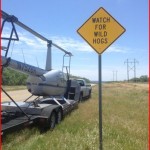
Wild hog hunting is all the rage.
Outfitters are specializing in taking clients on hunts with night vision equipped rifles. There are hog eradication businesses with horses and packs of dogs. Heck, there are even reality television shows about hunting hogs.
For quantity of hogs taken, the pinnacle is aerial shooting.
Kyle Lange, of Lange Helicopters, has been shooting out of a helicopter since 1984. He started as a child helping with the family business.
Now as a pilot, much of Kyle’s business is dedicated to hog control.
We sat down to discuss his business with a focus on the shooting aspect.
Tell us about your business.
Kyle Lange (KL) – We operate a helicopter service. Our home base is in Mertzon about 30 miles south of San Angelo, Texas. We travel all around Texas and sometimes outside the state taking the helicopters by trailer to where we are going to work.
We use both the Robinson R22 helicopter – a two seat model – and a four seat R44. Which one we use depends on the job.
Currently, the business is about 20% livestock round-up, 20% wildlife surveys, and 60% hog and predator control.
Since you asked me to talk about the shooting part, we have long been doing coyote control – since I was a kid. Then a few years ago, all of a sudden, the calls were about wild hogs. In 2010, the business was about 30% hogs and 70% coyotes, but this has moved towards the hogs more and more each year. So far in 2013, it has been about 60% hogs.
Who does the shooting?
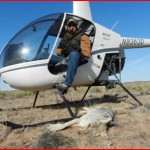
KL – Depends on the job. I still do some for my father. When I fly, I have a rotation of five shooters that I use for straight up eradication jobs.
On other jobs, landowners and their guests will do the shooting.
Do you offer helicopter shoots for sale to the general public?
KL – Very little. I have occasionally done this for an outfitter.
About as close as I normally get is when a landowner, his employee or associate does the shooting. These guys generally have very big tracts of property.
Of course, my nightmare is getting a call from a guy with 50 acres in the hill country with 8 buddies that want to shoot. No thanks. (Laughs) Or for a 13 year old’s birthday party and the caller asks if there are drink holders so the mom can put her beer down in case she wants to take a picture if junior shoots a big one. Uh NO, give me a break! I am NOT a carnival ride.
Obviously, but sounds like there is consumer demand.

True. To provide a “to the general public” offering, there is finding land that will sustain that kind of shooting and landowners being cool with random folks on the trigger. Most of the big landowners would rather come along themselves or just have us handle it. Using professional shooters, we can usual remove 90% to 100% and be done with it.
The other obstacle is the skill set required. Some folks are very competent. However, it makes me very nervous when the “shooter” has never killed anything in their life other than a cockroach or has never even held an AR-15 before their first flight.
I have been approached by a shooting school and a hunting outfitter to put on a “class”. It would not be shooting live hogs, but more like practice on inanimate targets for the experience. We’ll see if that really comes together.
Otherwise, I have put together shoots for a Suppressor and an Optics manufacturer with the landowner getting the service for free. All of these folks were very experienced shooters.
OK, you mentioned percentages. Let’s get to the “money” question – how many hogs and coyotes do you shoot per year?
KL – I’m not really into bragging on “body counts”. I don’t scratch notches in the side of my AR-15.
From a financial impact, we may do very well for a landowner even when it is not huge numbers on a particular job.
For example, taking out the 2 coyotes killing 20 $200 a head sheep is a big deal to a rancher. Getting the last group of 30 or 40 hogs out of a farming area where the animals have already been extensively hammered on can make a bigger difference than taking 250 out of some open ranch land.
If they are there, we can get to them.
So not even a hint?
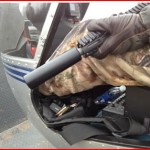
KL – In the right spot, we can shoot a few hundred in a few days. I am not sure most folks can put that into perspective.
How does the aerial shoot go?
KL – Start with getting intel from the locals. We then make a circuit around the area looking for rooting and around the water holes.
In the R22, the shooter sits in the left seat and I fly from the right.
Wild pigs typically break out running in groups of 8 to 12. I work to position us behind them. We close in to about 20 to 30 yards…sometimes 40 and slow down enough trying to match their speed.
You shoot the last one in line and start working forward.
Obviously, that is ideal. The pigs break ranks or make hard turns or the big ones start out distancing the little ones.
It is a doable shot if I have to make a left turn to follow-up on one, but I’ll only let you try it if you are buying the ammo. Absolutely, don’t shoot if I turn right. Be patient and let me get back around behind them.
What firearms do you shoot for this and why did you make that choice?
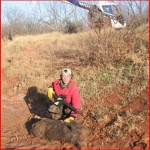
KL – Well, that has been an evolution.
We had always used shotguns with 00 or #4 buckshot. We sometimes still do. (Laughs) For years, I shot coyotes out of the helicopter with a Ruger Red Label over/under! Of course, coyotes are not high volume.
The pigs made us start experimenting with rifles to get the range and knockdown. We now use rifles the majority of the time. The distance, knockdown, and quicker reloads make rifles a better platform for what we do over the shotgun. It is has been a lot trial and error, though.
I started with a match grade full length AR, but I suppose the tolerances were too tight keep up with high volume shooting. And it just wouldn’t shoot cheap ammo.
We very briefly tried AKs. Good knockdown power and they cycled any ammo you put in it. Their downfall for us is that we could not get the accuracy we needed. Out past 25 yards, these were a failure. I am a big fan of the 7.62×39 for getting an immediately drop to the shot. I don’t know if our AK’s were too cheap or what.
Next was the AR lowers with 7.62×39 uppers. These were completely unreliable. There were lots of failures to feed or cycle.
It is too expensive in down time while you are trying to work for jacking around with a rifle that won’t run.
What is “perfection”?
KL – (Laughs) Well, I’m still looking, but I am currently using suppressed .223/5.56mm AR-15s in Short Barrel Rifle (SBR) length with gas piston uppers and illuminated dot optics.
Early on, we realized illuminated dot optics were revolutionary for what we do.
The game changer, for us anyway, was gas pistons for AR’s. It worked so well, I’m almost reluctant to say so my competitors don’t figure it out (laughs).
The impingement ARs had to be cleaned often – sometimes multiple times in a day. We used multiple bolts switching out as we went. I’ve got too much going on taking care of the aircraft and generally keeping things moving to put up with a gun that won’t keep running.
Also, the piston rifle doesn’t spray carbon all over my Plexiglas windshield. If you think guns are expensive, take a guess at replacing a helicopter windshield. You could buy several of the firearms setup as mentioned….not counting the down time from flying.
This type of use is very hard on a firearm. I love guns and shooting, but the ones we use for this are tools. I expect guns to crater at some point which is why we always bring a few backup rifles.
I am still opened minded. Maybe the next thing is out there. In fact, we have done some product testing for manufacturers and have had a few come out to fly with us to test their stuff.
Who knows what we might find next. I have been reading up on the SIG 556R.
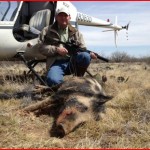
I am surprised you went back to .223 in your working guns. I would not have guessed that it had enough punch.
KL -.223 is a compromise for sure. Full metal jackets don’t work because you can’t tell the hits as you don’t get an instant knockdown. I buy the most economical hollow point .223 ammo I can find by the pallet – literally.
When a group of pigs breaks, there will usually be 2 or 3 big ones and 7 to 8 little ones. .223 is fine for the little pigs and the bigger pigs….well, shoot more than once. It really is “enough gun” for 80% of the targets.
The.308 is great for knocking down the pigs. You get an instant and dramatic response on hits. Which is nice as the pilot being able to tell when to move on to the next one, but it is too expensive and bit much for what we need.
One of the landowners I fly for uses a .300 Blackout. It is super. I just can’t afford to shoot it. Maybe if it goes main stream enough to bring the cost down or someone offers to sponsor me!
7.62×39 seemed like it was going to be the sweet spot between .223 and .308. Very economical and packed a lot of punch. I just never had a lot of luck with it.
I have no argument these other calibers have a lot more punch. If you were to only going to do this one time in your life, then sure, bring a .308 or .300 Blackout or whatever you want.
I don’t dislike these cartridges by any means and I use them in non-aerial shooting applications. I have lately been using a 6.5 Grendel for hunting from the deer stand.
Oh, I get a lot of “expert” advice. It is annoying to be told by someone after their first shooting session that we ought to be using .458 SOCOM or similar nonsense. Yeah, that’s not real practical.
You mention SBR and suppressors above. How do these help?
KL – A short barrel is not required, but it makes the rifle easy to maneuver inside the helicopter – especially once you slap a suppressor on it. One rifle is a 10.5” and the other is a 12”.
I don’t always make someone bringing their own rifle use a suppressor, but I prefer it and always use a suppressor on my guns.
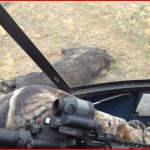
Why use a suppressor when the helicopter is already plenty loud?
KL – Seeing a helicopter flying low around a pasture may get noticed. Hearing shots being fired out that helicopter will get noticed! We are often too far off the beaten path for neighbors to notice because many of the ranches we fly are measured in square miles not acres. But every little bit helps.
I have noticed the reduced noise doesn’t spook livestock in close proximity.
Really, we use a suppressor for me, the shooter and the aircraft. And probably not in that order! It keeps the blast reduced which helps the shooter and keeps it away from the helicopter.
By the way, I have not had great luck with quick detach suppressor mounts. The ones I’ve tried start to rattle loose over time. A suppressor falling off while flying would be about the same as throwing it in the ocean. I can imagine the phone call to the ATF trying to explain how a suppressor got lost would not be a bunch of fun.
I think it was a design flaw. I was given the suggestion of pinning the suppressor to the quick detach mount. Really?
Of course, dropping stuff is a worry – I did stick reflective tape on the shell deflector in the event somebody drops the rifle. Thankfully that hasn’t happened – yet.
Threaded mounting stays on?
KL – With a crush washer (Authors note: A crush washer is very different from a lock washer). If I am really feeling nervous about losing one that day, I will also use a little bit of Teflon tape on the threads.
You haven’t mentioned any brand names.
KL – I use a mix of manufacturers. For example, one lower is a Colt and another is DPMS. We are using aftermarket pistons in the uppers.
I started with the Trijicon Reflex for optics and later transitioned to the 1X4 Accupoint with a German reticule. There are a lot of nice 1×4 scopes on the market, but they have too many lines, dashes and circles on the reticule for what we do.
Once we discovered the Trijicon SRS that is all we use now. We love it. Just a user friendly, simple dot. When you’re super close impact is below the dot and when you’re 20-30-40 yards just put it on the spot.
You mentioned product testing. Can you give some examples?
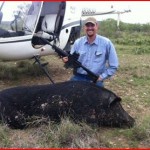
KL – I get a few shooters testing various products. We specifically do some product testing for Silencer Tech.
I met the owners of Faxon Firearms recently. I got chance to shoot their new upper on the ground and we took the owner up in the helicopter. He took a hog from the air. I am looking forward to the chance to really put one of these through the wringer.
This is really hard on firearms. We don’t have time to baby stuff or nurse it along.You’d be surprised how many firearms people bring that just crater after a busy day…sometimes less. And it is not exactly easy shooting out of a helicopter.
I do enjoy talking to manufacturers and see what we can find out.
I am surprised more companies are not using helicopter eradication in their marketing. I don’t think the people they are marketing to would be offended.
You mentioned that shooting moving targets out of a moving helicopter is not easy. Is there a secret?
KL – It is more like shooting a shotgun than careful bench rest aim. You keep swinging to keep even with the pig, but not way ahead of it like a bird. When the dot gets about to the right spot, shoot! And keep shooting until it drops. You have got stay loose. If you’re tense, you are not going to connect.
It is hard to describe. My regular shooters call it getting into the rhythm. On a good day, professionals kill 90 to 100 percent of what they see. First timers are lucky to get a third or half.
Everything depends. I had a Trijicon employee sum it up last April. He said shooting moving targets from an unstable platform like this helicopter only can be really appreciated if you understand all the fundamentals of shooting and you can shoot.
Getting into rhythm is all in your head. Under focus or over focus and you will self-destruct. The more you miss the harder you try and the worse it gets. One pig is easy to shoot. When there are 20, you still have to shoot them one at a time. Like the saying goes, you have to learn how to take your time in a hurry.
I have read that you have satellite radio and play music while you fly.
Yep. Classic rock.
To wrap up, what is the best part of your work?
I love that I get to fly. I absolutely look forward to the next job and would rather be working than have time off. I’m not so sure I would do so well behind a desk.
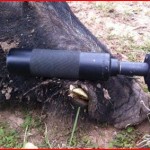
By S.J.S.
Latest posts by Mike Coker (see all)
- X-BULL Gen 3.0 Off-Road Recovery Traction Boards – June 25, 2025
- The Critter: Old-school flats skiff! – May 25, 2025
- Pros and Cons of Different Off-Road Traction Boards – May 23, 2025
Leave a Reply